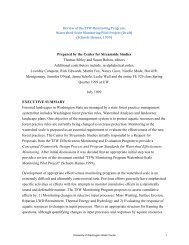Copyright 2012 Aileen M. Echiverri-Cohen - University of Washington
Copyright 2012 Aileen M. Echiverri-Cohen - University of Washington
Copyright 2012 Aileen M. Echiverri-Cohen - University of Washington
Create successful ePaper yourself
Turn your PDF publications into a flip-book with our unique Google optimized e-Paper software.
The relationship between treatment modality, time, and AB showed significant variance in<br />
intercepts across participants, Lag 2: var(u0j) = .02, χ 2 (1) = -24.29, p < .05, Lag 3: var(u0j) = .04,<br />
χ 2 (1) = -65.93, p < .05, Lag 4: var(u0j) = .01, χ 2 (1) = -119.45, p < .05, Lag 5: var(u0j) = .01, χ 2 (1)<br />
= -131.09, p < .05. In this model, on average, the effect <strong>of</strong> time (i.e., fixed effects) significantly<br />
predicted AB at post-treatment for lags 3-5, the lags affected by the AB effect (lag 3: F(1, 34.31)<br />
= 6.02, p < .05, d = 0.84; B = .04, SE = .02, t(34.31) = 2.45, p < .05, lag 4: F(1, 35.5) = 7.7, p <<br />
.05, d = 0.93, B = .04, SE = .01, t(35.5) = 2.78, p < .05, lag 5: F(1, 40.03) = 6.42, p < .05, d =<br />
0.80, B = .04, SE = .02, t(40.03) = 2.53, p < .05), suggesting that, across treatment modality,<br />
participants showed increased accuracy on lags 3-5 from pre-treatment to post-treatment.<br />
To examine if the time effect findings were consistent across treatment modalities, we<br />
examined treatment modality, time, and the interaction term in the model. The interaction <strong>of</strong><br />
treatment term predicted AB for lags 1 and 4 at trend levels, F(1, 35.9) = 3.95, p = .06; B = -.06,<br />
SE = .03, d = 0.66, t(35.9) = -2, p = .06); F(1, 34.1) = 3.38, p = .08, d = 0.63; B = -.05, SE = .03,<br />
t(34.1) = -1.84, p = .08), because they were not significant, further breakdown <strong>of</strong> the interactions<br />
were not conducted, although the pattern is consistent with individuals treated with<br />
psychotherapy showing increased accuracy at post-treatment than at pre-treatment.<br />
Taken together, there was an increase <strong>of</strong> AB accuracy on lags 3, 4, and 5 from pre- to<br />
post-treatment, indicating a clear pattern <strong>of</strong> increased inhibitory functioning on critical AB lags<br />
from pre- to post-treatment for both PE and SER. Inclusion <strong>of</strong> the treatment modality x time<br />
interaction indicated some, albeit at a trend level, differences between PE and SER from pre- to<br />
post-treatment.<br />
Prepulse Inhibition <strong>of</strong> Startle. In contrast, the relationship between treatment modality,<br />
time, and PPI showed negligible variance in intercepts across participants. The effect <strong>of</strong> time<br />
35
















